lock PONTIAC GRAND AM 1998 Workshop Manual
[x] Cancel search | Manufacturer: PONTIAC, Model Year: 1998, Model line: GRAND AM, Model: PONTIAC GRAND AM 1998Pages: 370, PDF Size: 16.11 MB
Page 186 of 370
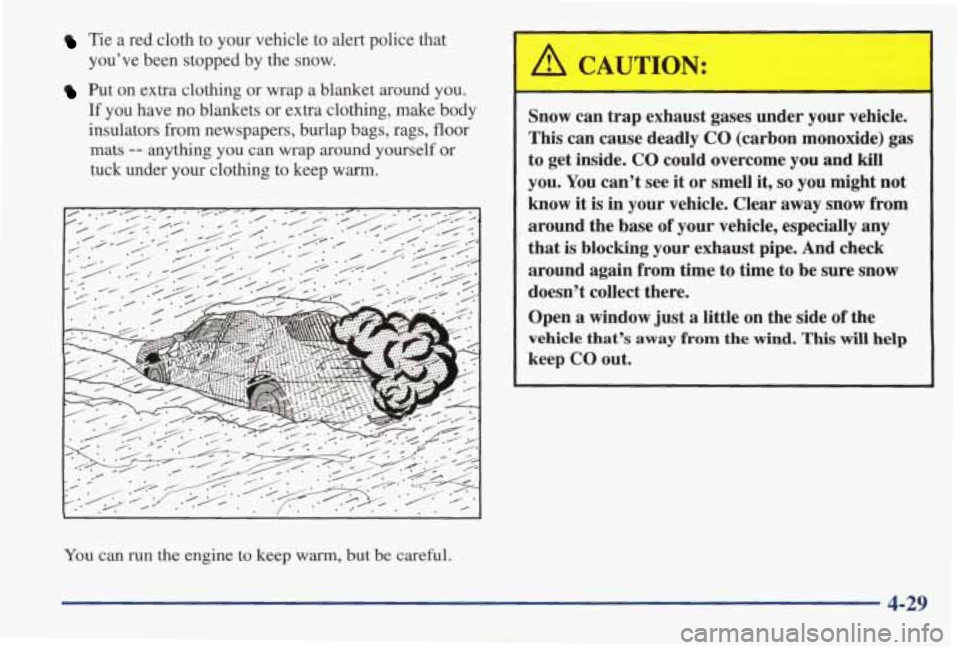
Tie a red cloth to your vehicle to alert police that
you’ve been stopped by the snow.
Put on extra clothing or wrap a blanket around you.
If you have no blankets or extra clothing, make body
insulators from newspapers, burlap bags, rags, floor
mats
-- anything you can wrap around yourself or
tuck under your clothing to keep warm.
A CAUTION:
Snow can trap exhaust gases under your vehicle.
This can cause deadly CO (carbon monoxide) gas
to get inside.
CO could overcome you and kill
you. You can’t see it or smell it, so you might not
know it
is in your vehicle. Clear away snow from
around the base of your vehicle, especially
any
that is blocking your exhaust pipe. And check
around again from time to time to be sure snow
doesn’t collect there.
Open
a window just a little on the side of the
vehicle that’s away from the wind. This will help
keep CO out.
You can run the engine to keep warm, but be careful.
4-29
Page 188 of 370
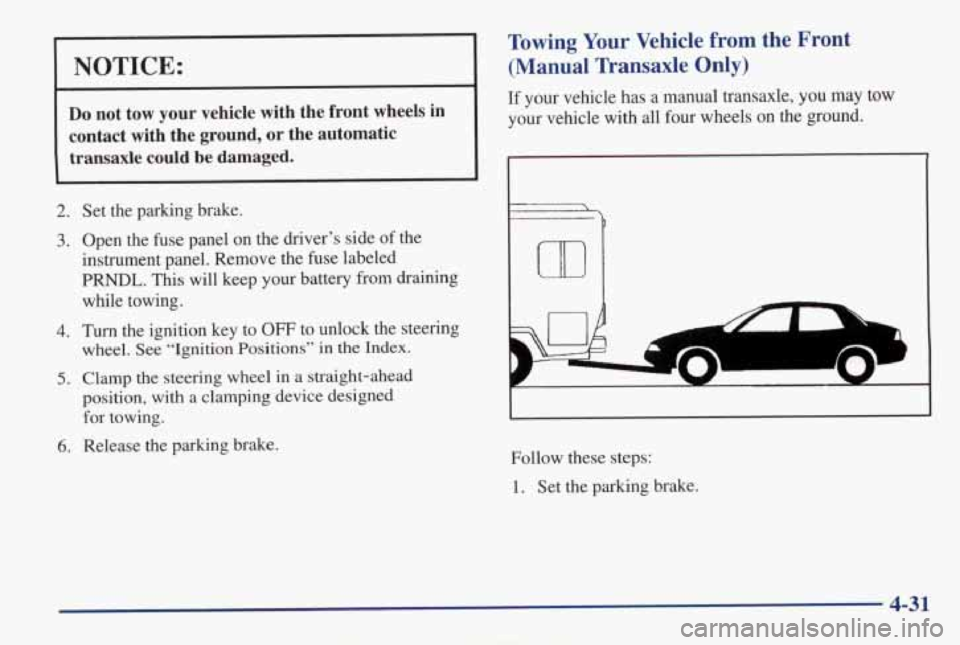
NOTICE:
Do not tow your vehicle with the front wheels in
contact with the ground, or the automatic transaxle could be damaged.
2.
3.
4.
5.
6.
Set the parking brake.
Open the fuse panel on the driver’s side of the
instrument panel. Remove the fuse labeled
PRNDL. This will keep your battery from draining
while towing.
Turn the ignition key to OFF to unlock the steering
wheel.
See “Ignition Positions” in the Index.
Clamp the steering wheel in a straight-ahead
position, with a clamping device designed for towing.
Release the parking brake.
Towing Your Vehicle from the Front
(Manual Transaxle Only)
If your vehicle has a manual transaxle, you may tow
your vehicle with all four wheels on the ground.
F
@- I
Follow these steps:
1. Set the parking brake.
4-31
Page 189 of 370
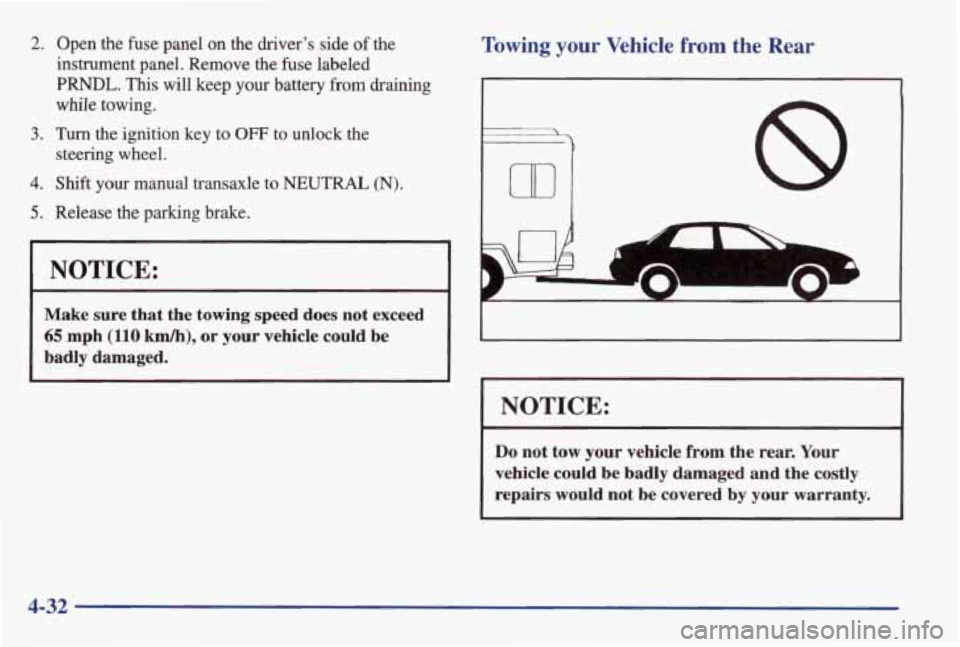
2.
3.
4.
5.
Open the fuse panel on the driver’s side of the
instrument panel. Remove the fuse labeled
PWL. This will keep your battery from draining
while towing.
Turn the ignition key to OFF to unlock the
steering wheel.
Shift your manual transaxle to NEUTRAL (N).
Release the parking brake.
.. -
NOTICE:
Make sure that the towing speed does not exceed
65 mph (110 km/h), or your vehicle could be
badly damaged.
Towing your Vehicle from the Rear
b
m 8
c1
5
NOTICE:
Do not tow your vehicle from the rear. Your
vehicle could
be badly damaged and the costly
repairs would not be covered by your warranty.
4-32
Page 195 of 370
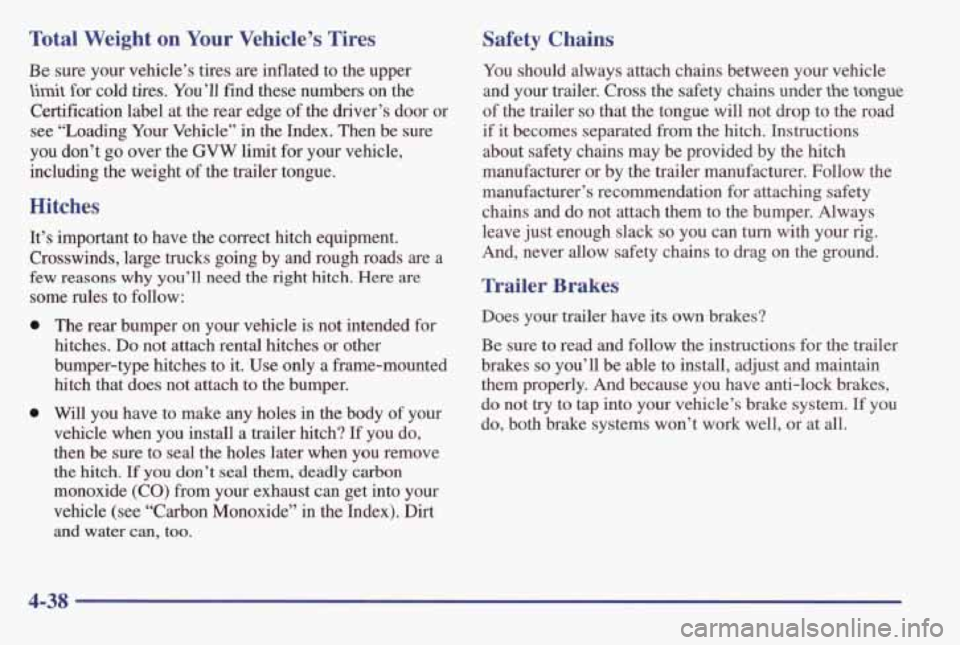
Total Weight on Your Vehicle’s Tires
Be sure your vehicle’s tires are inflated to the upper
limit for cold tires. You’ll find these numbers on the
Certification label at the rear edge of the driver’s door or
see “Loading Your Vehicle” in the Index. Then be sure
you don’t
go over the GVW limit for your vehicle,
including the weight of the trailer tongue.
Hitches
It’s important to have the correct hitch equipment.
Crosswinds, large trucks going by and rough roads are a
few
reasons why you’ll need the right hitch. Here are
some rules to follow:
0
0
The rear bumper on your vehicle is not intended for
hitches. Do not attach rental hitches or other
bumper-type hitches to it. Use only a frame-mounted
hitch that does not attach to the bumper.
Will you have to make any holes in
the body of your
vehicle when you install a trailer hitch? If you do,
then be
sure to seal the holes later when you remove
the hitch. If you don’t seal them, deadly carbon
monoxide (CO) from your exhaust can get into your
vehicle
(see “Carbon Monoxide” in the Index). Dirt
and water can, too.
Safety Chains
You should always attach chains between your vehicle
and your trailer. Cross the safety chains under
the tongue
of the trailer so that the tongue will not drop to the road
if
it becomes separated from the hitch. Instructions
about safety chains may be provided by the hitch
manufacturer
or by the trailer manufacturer. Follow the
manufacturer’s recommendation for attaching safety
chains and do not attach them to the bumper. Always
leave just enough slack
so you can turn with your rig.
And, never allow safety chains to drag on the ground.
Trailer Brakes
Does your trailer have its own brakes?
Be sure to read and follow the instructions for the trailer
brakes
so you’ll be able to install, adjust and maintain
them properly.
And because you have anti-lock brakes,
do not try to tap into your vehicle’s brake system. If you
do, both brake systems won’t work well, or at
all.
4-38
Page 208 of 370
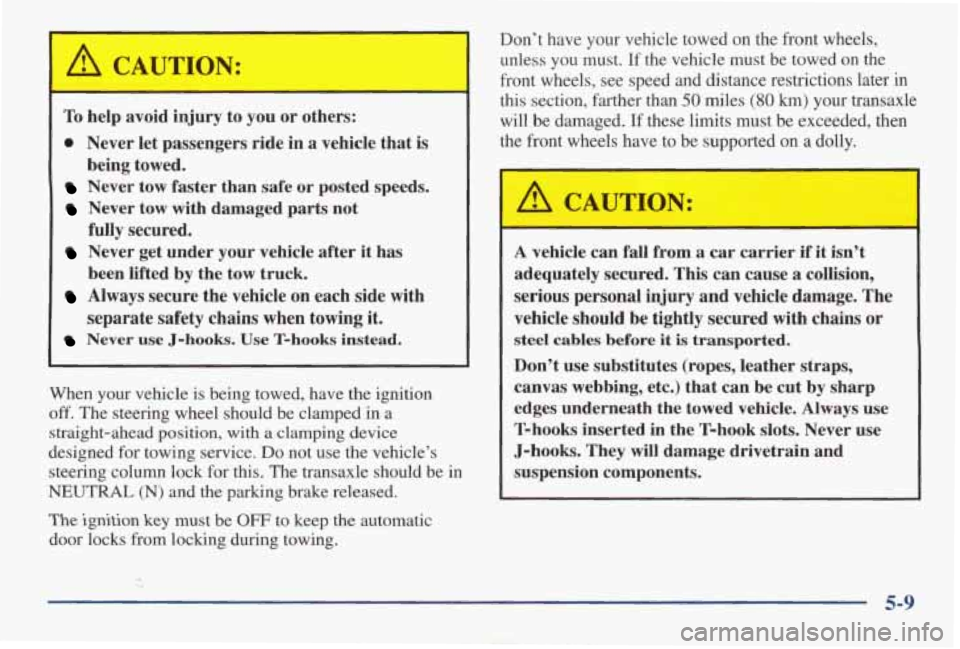
To help avoid injury to you or others:
0 Never let passengers ride in a vehicle that is
Never tow faster than safe or posted speeds.
Never tow with damaged parts not
fully secured.
Never get under your vehicle after it has
been lifted
by the tow truck.
Always secure the vehicle on each side with
separate safety chains when towing it.
Never use J-hooks. Use T-hooks instead.
being towed.
When your vehicle is being towed, have the ignition
off. The steering wheel should be clamped in a
straight-ahead position, with
a clamping device
designed for towing service.
Do not use the vehicle’s
steering column lock for this. The transaxle should be
in
NEUTRAL (N) and the parking brake released.
The ignition key must be OFF to keep the automatic
door locks from locking during towing. Don’t have your vehicle towed on the
front wheels,
unless you must.
If the vehicle must be towed on the
front wheels, see speed and distance restrictions later
in
this section, farther than 50 miles (80 km) your transaxle
will be damaged.
If these limits must be exceeded, then
the front wheels have to be supported on a dolly.
A vehicle can fall from a car carrier if it isn’t
adequately secured.
This can cause a collision,
serious personal injury and vehicle damage. The
vehicle should be tightly secured with chains
or
steel cables before it is transported.
Don’t use substitutes (ropes, leather straps,
canvas webbing, etc.) that can be cut
by sharp
edges underneath the towed vehicle. Always use
T-hooks inserted in the T-hook
slots. Never use
J-hooks. They will damage drivetrain and
suspension components.
5-9
Page 210 of 370
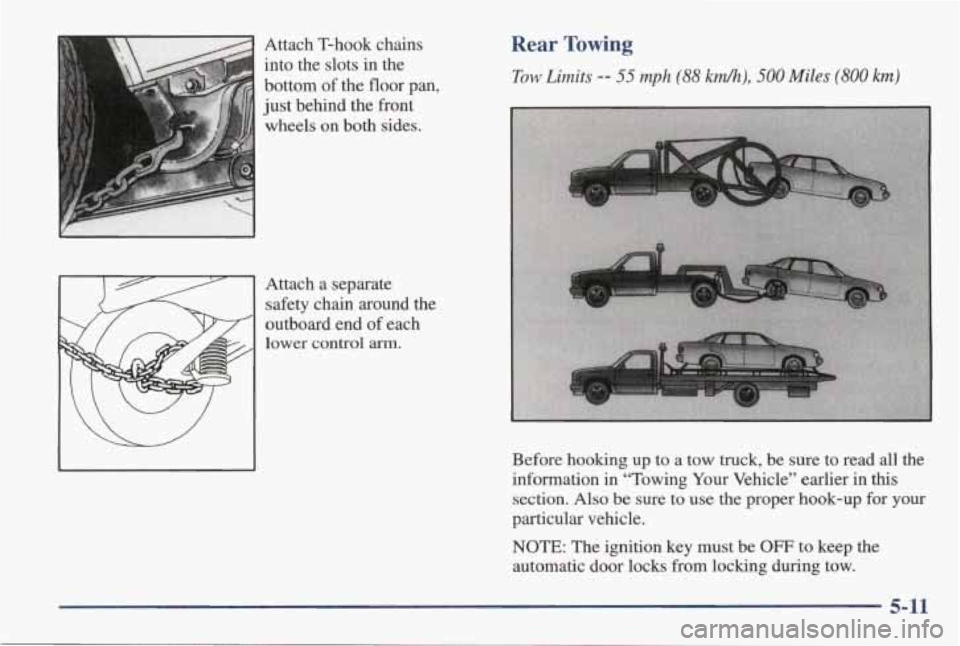
Attach T-hook chains
into the slots in the
bottom
of the floor pan,
just behind the front
wheels on both sides.
Attach a separate safety chain around the
outboard end
of each
lower control arm.
I\ - 1 I
Rear Towing
Tow Limits -- 55 mph (88 kmh), 500 Miles (800 km)
Before hooking up to a tow truck, be sure to read all the
information in “Towing Your Vehicle” earlier in this
section. Also be sure to use the proper hook-up for your
particular vehicle.
NOTE: The ignition key must be OFF to keep the
automatic door locks
from locking during tow.
5-11
Page 222 of 370
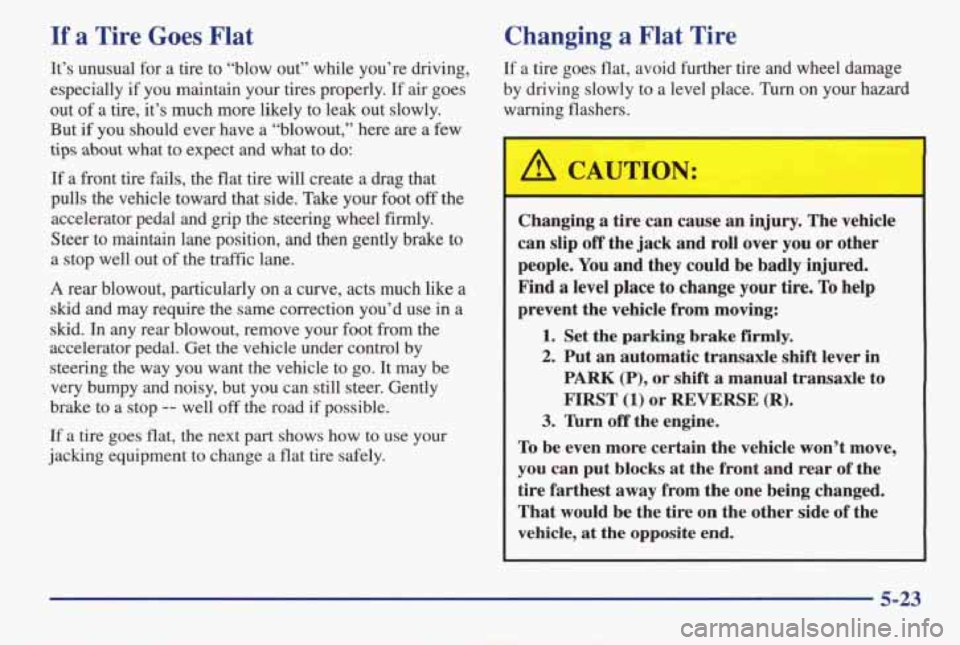
If a Tire Goes Flat Changing a Flat Tire
It’s unusual for a tire to “blow out” while you’re driving, If a tire goes flat, avoid further tire and wheel damage
especially
if you maintain your tires properly. If air goes by driving slowly to a level place. Turn on your hazard
out of a tire, it’s much more likely to leak out slowly. warning fla\
shers.
But if you should ever have a “blowout,” here are a few
tips about what to expect and what to do:
If a front tire fails, the flat tire will create a drag that
pulls the vehicle toward that side. Take your foot
off the
accelerator pedal and grip
the steering wheel firmly.
Steer to maintain lane position, and then gently brake to
a stop well out
of the traffic lane.
A rear blowout, particularly on a curve, acts much like a
skid and may require the same correction you’d use in a
skid. In any rear blowout, remove your foot from the
accelerator pedal. Get the vehicle under control
by
steering the way you want the vehicle to go. It may be
very bumpy and noisy, but you can still steer. Gently
brake to
a stop -- well off the road if possible.
If a tire goes flat, the next part shows how to use your
jacking equipment to change a flat tire safely. Changing
a tire
can cause an injury. The vehicle
can slip
off the jack and roll over you or other
people. You and they could be badly injured.
Find
a level place to change your tire. To help
prevent the vehicle from moving:
1. Set the parking brake firmly.
2. Put an automatic transaxle shift lever in
PARK (P), or shift a manual transaxle to
FIRST (1) or REVERSE (R).
3. lbrn off the engine.
To be even more certain the vehicle won’t move,
you can put blocks at the front and rear of the
tire farthest away from the one being changed.
That would be the tire
on the other side of the
vehicle,
at the opposite end.
5-23
Page 239 of 370
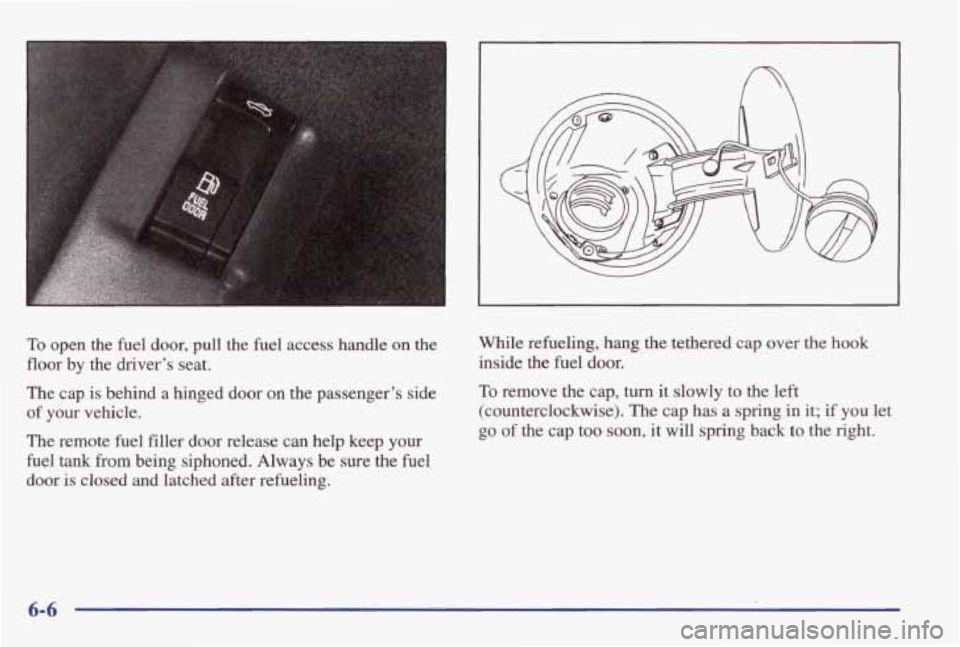
II
II
To open the fuel door, pull the fuel access handle on the
floor by the driver’s seat.
The cap is behind a hinged door on the passenger’s side
of your vehicle.
The remote fuel filler door release can help keep your
fuel
tank from being siphoned. Always be sure the fuel
door
is closed and latched after refueling. While refueling, hang the tethered cap
over the hook
inside the fuel door.
To remove the cap, turn it slowly to the left
(counterclockwise). The cap has
a spring in it; if you let
go
of the cap too soon, it will spring back to the right.
6-6
Page 240 of 370
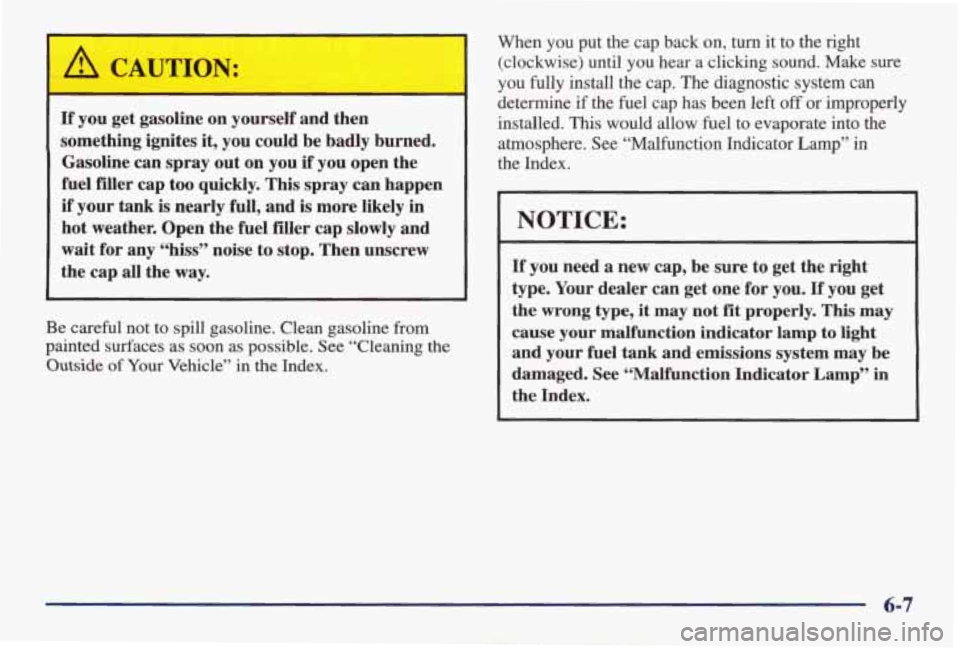
’ A CAUTION:
If you get gasoline on yourself and then
something ignites it, you could be badly burned.
Gasoline
can spray out on you if you open the
fuel filler cap too quickly.
This spray can happen
if your tank is nearly full, and is more likely in
hot weather. Open the fuel filler cap slowly and
wait for any “hiss” noise to stop. Then unscrew
the cap
all the way.
Be careful not to spill gasoline. Clean gasoline from
painted surfaces as soon as possible. See “Cleaning the
Outside of Your Vehicle” in the Index. When you put the
cap back
on, turn it to the right
(clockwise)
until you hear a clicking sound. Make sure
you
fully install the cap. The diagnostic system can
determine
if the fuel cap has been left off or improperly
installed.
This would allow fuel to evaporate into the
atmosphere. See “Malfunction Indicator
Lamp” in
the Index.
NOTICE:
If you need a new cap, be sure to get the right
type. Your dealer can get one for you.
If you get
the wrong type,
it may not €it properly. This may
cause your malfunction indicator lamp to
light
and your fuel tank and emissions system may be
damaged.
See “Malfunction Indicator Lamp” in
the Index.
6-7
Page 248 of 370
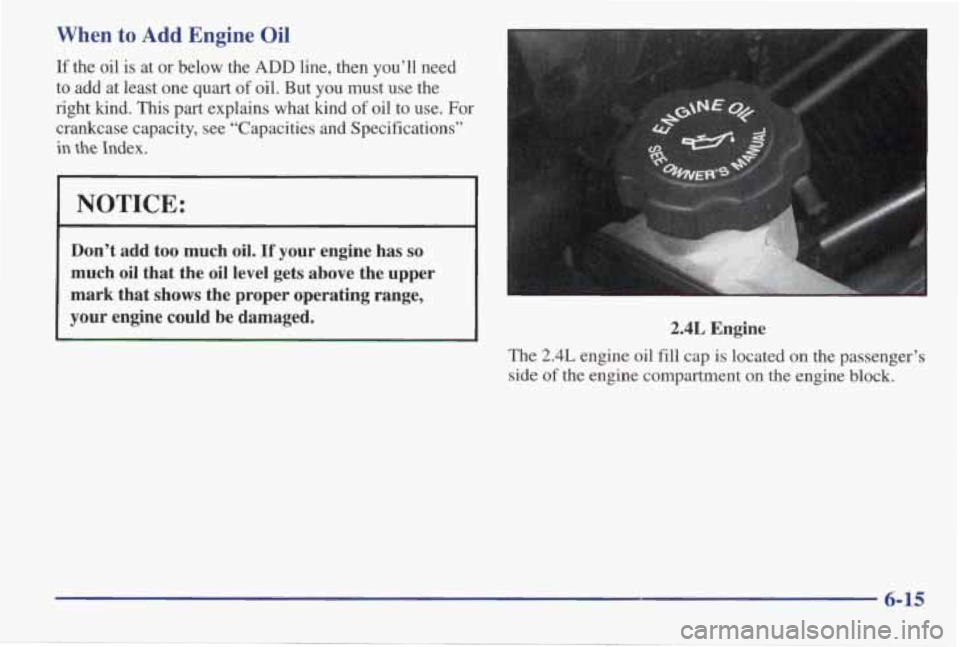
When to Add Engine Oil
If the oil is at or below the ADD line, then you’ll need
to add at least one quart
of oil. But you must use the
right kind. This part explains what kind
of oil to use. For
crankcase capacity, see “Capacities and Specifications”
in the Index.
I NOTICE:
Don’t add too much oil. If your engine has so
much oil that the oil level gets above the upper
mark that shows the proper operating range,
your engine could be damaged.
2.4L Engine
The 2.4L engine oil fill cap is located on the passenger’s
side
of the engine compartment on the engine block.
6-15